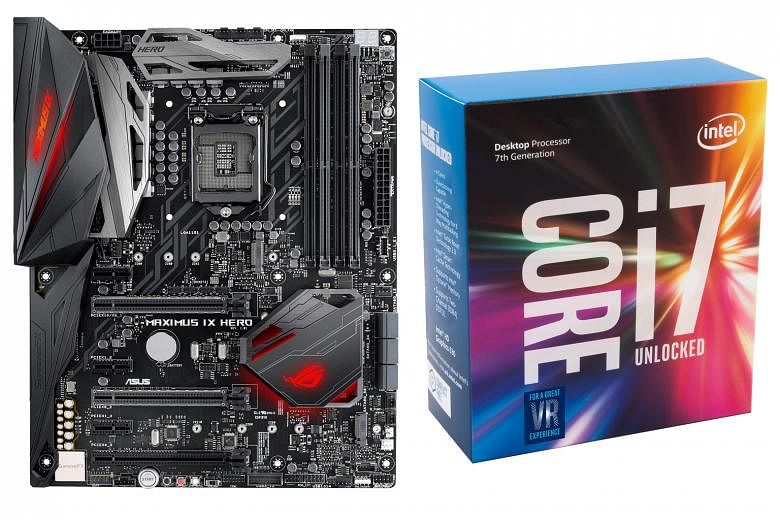Intel has finally faltered in its efforts to maintain Moore's Law, which has endured for more than 50 years. Its latest seventh-generation Kaby Lake Core processors mark that breaking point.
In 1965, Intel co-founder Gordon Moore observed that computing power roughly doubles every two years. This became Moore's Law.
However, Intel, whose processors are in everything from laptops to servers, has found it increasingly difficult in recent years to keep up this pace of improvement.
Kaby Lake is the third iteration of Intel processors to be built in a 14nm manufacturing process.
Notably, Intel has found it challenging and costly to shrink its chips, which usually leads to improved performance.
-
TEST SET-UP
-
Intel Core i7-7700K
-
16GB DDR4 RAM
-
Asus ROG Maximus IX Hero
-
Samsung 960 PRO SSD 512GB
-
Nvidia GeForce GTX 1070
(376.33 drivers) -
Windows 10 Anniversary Edition
Last year, Intel said it was moving away from its tick-tock model of shrinking the manufacturing process (tick), followed by optimising the chip design and architecture (tock). It had planned to move to a 10nm process but this has been delayed to the second half of this year.
Meanwhile, Kaby Lake has been offered as a stopgap solution for PC makers which are already treading water. Market-tracker Gartner reported that the PC industry last year declined for the fifth straight year.
TESTING THE CORE i7-7700K
The flagship Kaby Lake desktop processor is the quad-core Core i7-7700K, which is clocked at 4.2GHz compared with 4GHz on its i7-6700K predecessor.
In Turbo Boost mode, the new model goes to 4.5GHz, up from 4.2GHz on the i7-6700K.
Complementing these processors are the new 200-Series motherboards, now available from brands like Asus, Gigabyte and MSI.
Feature-wise, they are mostly similar to the older 100-Series, though the 200-Series adds support for Intel Optane technology.
To be available later this year in the form of 16GB and 32GB memory modules, Intel Optane technology uses special modules as a high- speed cache to improve system performance and responsiveness.
In my testing (see test set-up for detailed configuration), the Core i7-7700K scored 5,035 in PCMark Home, which tests basic computing tasks, compared with 4,872 for the i7-6700K.
In the Cinebench R15 rendering benchmark, the i7-7700K managed a score of 998, compared with 934 for the i7-6700K.
The i7-7700K offers slightly better performance in games compared with its predecessor. In Doom, my test system got around 147 frames per second (fps) with the i7-7700K, compared with 141fps for the 6700K.
In Civilization VI's AI benchmark, which measures the time the computer takes to decide its next move in this turn-based strategy game, the i7-7700K took 20.96sec while the i7-6700K took 21.79sec.
In short, Kaby Lake offers marginal performance gains. However, enthusiasts will be pleased by the overclocking potential of this chip. The Core i7-7700K set eight world records on its launch day, with overclocking experts pushing the processor to 7.2GHz with liquid helium cooling.
Even casual users can easily overclock the processor beyond its default speeds with the push of a button. The Asus motherboard used in my testing has a one-click overclocking profile that is said to be 80 per cent successful at achieving a clock speed of 5GHz with the Core i7-7700K. Other high-end motherboards have similar overclocking features.
KABY LAKE REQUIRED FOR NETFLIX 4K ON PC
A Kaby Lake processor is a prerequisite for streaming Netflix 4K videos on the computer.
While 4K streaming has been available on television sets and media streamers, content producers have not allowed that on PCs because of piracy concerns.
These concerns have been assuaged by a hardware-based digital rights management system, though it comes with some major caveats.
In order to play Netflix 4K videos, your PC must have a Kaby Lake chip with a 4K display (with HDCP 2.2 support) connected to HDMI 2.0 or DisplayPort.
Desktop PC users have to use Kaby Lake's integrated graphics chip instead of a dedicated graphics card from AMD or Nvidia, as both these manufacturers have not been certified yet.
You also need to have Windows 10 Anniversary Update installed and can only use the Microsoft Edge browser for Netflix 4K.
SHOULD YOU UPGRADE TO KABY LAKE?
Desktop PC users who have an Intel CPU from the past two to three years should probably give Kaby Lake a miss.
If your PC is older than that, but still in working condition, you may wish to wait till AMD's Ryzen processors are launched in the next few months before deciding.
Notebooks and other low-power devices, however, will probably see improvements in battery life. Intel has also promised significant performance gains when using the chip's integrated graphics feature.


